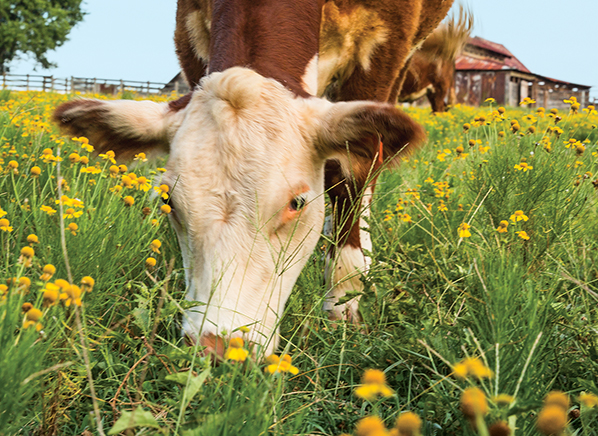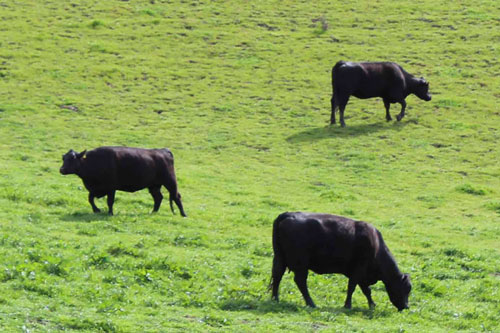The Due Diligence Series: the 2 Questions to Ask when Buying Red Meat
Guest User
In the second blog in my due diligence series, I’m focusing the spotlight on red meat. I’m frequently asked where I buy my meat from. I’ve devoted my life over the past decade, and have made a living out of, researching and seeking out the best quality food, drinks, personal care products and household cleaning products. For what we put in, on and breathe into our bodies directly and profoundly impacts our health. To not be concerned about such things is a complete anathema to me. It’s why my nickname is the quintessential qualitarian.
This extensive investigative process is called due diligence. I know from my days as a corporate lawyer the importance of doing a thorough due diligence diligence before making an acquisition. We would have an extensive checklist of items to investigate when acting on behalf of a purchaser to ensure that their acquisition was fruitful. Without formalising it, you might have a list of questions that you ask when buying a house, a car or a pet. I do the same when buying anything that touches my body (and on the occasions that I don’t, I often regret it).
In my health coaching sessions I give my clients an extensive shopping list that lists all of my favourite brands of products and stores in Sydney, Melbourne and the Gold Coast. This is mighty convenient as I save clients from doing the exhaustive investigative work that I already have done. But what if you don’t live in those locations? And even if you do, what I feel is more empowering than handing someone such a list, is to arm them with the very questions to ask when purchasing products. This gives you the information you need wherever you are in the world to make savvy choices.
In my due diligence series of blogs, I’ll be covering all of the basic staples so that you have all the questions to ask when purchasing products. Often this involves making enquiries of the producer when the relevant information is not transparent. But the more people who ask these pertinent questions, the more that suppliers will respond accordingly.
When it comes to meat I’m a passionate advocate of buying meat from wild or pastured animals free of hormones, antibiotics and industrial feed. I’ll be covering poultry and fish in another due diligence blog and focusing on red meat in this article.
Here are the relevant questions to ask when buying red meat:
1. ARE THE ANIMALS GRASS FED AND GRASS FINISHED?
Ruminant animals (meaning animals with a rumin e.g. beef and lamb) are designed to eat one thing and one thing only and that is grass (pasture). The high water mark is actually feeding cattle deep rooted native perennial grasses as opposed to cereal grass as I outline in a past blog post here but for the purposes of this blog I’m keeping it simple and referring to grass as opposed to grains as the ideal food source for ruminant animals.
Accordingly, we should first and foremost be asking for grass fed and finished meat. The “finished” part means finished on grass right up to the point of abattoir as opposed to finished on grains. Many farmers might say “oh yes it’s grass fed” but they will finish the animals on grains hence why the “finished” part of the question is important.
The reason why grains would be fed to cattle is to fatten them up before going to the abattoir.
Grains make cattle not only fat but also sick as grains are not their natural diet. Sick animals mean sick humans who then eat the animals. A mismatch between biology and environmental factors causes illness and disease in all living things, not just humans.
A piece of grass fed and finished meat often looks visibly different to grain fed meat. Grass fed meat will have the fat encapsulating the perimeter of the muscle meat where it is supposed to be, in contrast to a piece of grain fed meat where the fat is all marbled throughout the meat.The same effect happens to human muscle tissue when we overeat grains as they are not our natural diet especially in the large amounts that are consumed in modern society. There are some breeds of cows like wagyu which are exceptions to this rule where even grass fed wagyu will be marbled with fat.
2. ARE THE ANIMALS FREE OF ANTIBIOTICS AND HORMONES?
What an animal consumes ends up in the animal’s tissues. When cattle are administered antibiotics or hormones they can end up in our system when we in turn consume the animal as well as ending up in our waterways which we then incidentally consume. Antibiotic resistance and endocrine disrupting hormones are on the increase and have become significant health issues.
A farmer who feeds his cattle exclusively pasture and understands the importance of an animal’s welfare and natural diet is unlikely to want to, or even need to, administer antibiotics or hormones to his cattle because his cattle are much healthier and thrive much better when they are roaming around in sunshine and eating pasture as that is precisely what their biology is suited to. So whether the animal is grass fed and finished is the more relevant question you need to ask (and when eating out it’s the only question I ask about red meat).
In contrast, the industrial feedlot model produces sick cattle due to the abhorrent cramped and crowded conditions which breed illness and disease along with their unnatural grain based diet which also breeds illness and disease. In response, the sick cattle are then administered antibiotics which impacts their gut microbiome making them in the long term more susceptible to illness and disease so more or stronger antibiotics are administered and the cycle perpetuates. As a former hard core vegetarian / vegan, I would tout this animal welfare argument as my reason for abstaining from eating meat. But this conventional model is not what I, as a conscious omnivore, promote or support. There is a world of difference between the industrial feedlot model and a grass fed and finished model where farmers raise cattle humanely and organically with love and respect for both their animals and their environment. If you are struggling with the ethical issue of eating meat (as I once did) or know someone who is, I recommend reading the Vegetarian Myth by Lierre Keith or listening to Chef Pete Evans’ podcast interview of her or listening to Melissa Ambrosini’s interview of Daniel Vitalis called To Meat or Not to Meat. This blog is not intended to discuss or explore the ethical issues of eating meat but simply to elucidate the pertinent questions to ask if you do eat red meat.
If in the case of illness or other specific circumstances grass fed cattle are administered antibiotics as a last resort, the farmer should quarantine the animal in question until the antibiotics are flushed through their system before their milk or meat is used for human consumption.
When ruminant animals are 100% grass fed, and their systems are free of antibiotics and hormones, then in contrast to the industrial feedlot model:
- Their meat has a higher micro nutrient profile i.e. higher in vitamins and minerals (and nutrients are precisely what our bodies run on, so the more nutrients the more we can fire on all 6 cylinders and function optionally!)
- Their meat is more flavoursome (as nutrients are precisely what gives food its flavour)
- It is a more ethical way of farming. I believe it’s unethical to feed an animal something it is not designed to eat.
- It is a more environmentally sustainable way of farming.
These 2 questions are redundant if the animal is wild (e.g. deer, boar, goat, rabbit) as they will naturally eat their native diet, though sourcing wild animals is much trickier business unless hunting is your thing 😉 (and if it is then share the fruits of your labour with me… pleeeease!).
The above two questions are the same questions to ask if buying the organs of ruminate animals e.g. beef, calf or lamb livers, heart, kidney, sweetbreads etc
What about organic certification?
Organic certification is comforting but not entirely necessary if the ruminant animal is 100% grass fed and free of hormones and antibiotics. In fact organic certification isn’t a guarantee that the animals are 100% grass fed (they could be fed organic grains which is still not their natural diet). So simply because meat is certified organic does not excuse you from asking what the animals were fed.
The importance of balancing our muscle meat intake with bone broth
Methionine rich foods like muscle meat should always be teamed with glycine rich foods like bone broth as methionine and glycine work synergistically. Failure to consume bone broth or some other glycine rich food if you consume methionine rich foods like eggs or muscle meat leads to an excess of methionine in the body which raises homocysteine levels in the blood which in turn raises inflammation in the body. We know that inflammation is the root cause of all modern disease. I’m not saying that we shouldn’t consume muscle meat but that if we do we should ideally be consuming it with broth or some other glycine rich foods. I explain this in more detail in my online bone broth workshop. This wasn’t an issue for our hunter gatherer ancestors as they are nose to tail and in fact the bones, the fat and the organs of the animal were the most highly prized part of the animal with the muscle meat often discarded.
How much muscle meat to eat?
As a general rule, no more than one palm size and palm thickness of protein (which includes muscle meat, bone broth, seafood, dairy) per meal per day. I discuss in more detail what your plate should look like in my health coaching sessions.
Some of my favourite butchers in Sydney (this list is not exhaustive):
Kingsmore Meats, 22 Plumer road, Rose Bay ph 93634971 and 61-73 Mentmore Ave Rosebury
The Meat Store 262 Oxford St, Bondi Junction NSW ph 02 9386 9995 ($7 flat rate home delivery Sydney metro area via website)
1888 Certified Shop K2, 1 Kiaora Lan, Double Bay ph 02 9328 3200
Hudson Meats, 801 New South Head Rd Rose Bay ph 9371 1500, also at Cammeray, Lane Cove, Mosman, Drummoyne
David Jones sells a selection of 100% grass fed meat e.g. Cape Grim as do the large supermarket chains
GRUB online delivery
Feather & Bone online delivery or pick up from Rozelle or Marrickville
Lettuce Deliver online delivery of frozen pastured meats
Shoulder to Shank, 174-176 Military Road, Neutral Bay, ph 02 8969 6982
Harris Farm Butchers, 259 Pittwater Road, Manly, ph 02 9977 6469 sell some grass fed meats
Shiralee Meats, 25 Cross Street, Brookvale, ph 02 9939 0116 and coming soon to Manly
Fairlight Quality Meats, 154 Sydney Road, Fairlight, ph 02 9949 2460
Mona Vale Quality Butchers 18 Bunngan St, Mona Vale 02 9997 1581
Some of these butchers sell red meat that is exclusively grass fed and finished whereas others only sell only a selection that is 100% grass fed- so please ask!!
Check out your local farmers market too!
Did you find this blog helpful? I’d love to hear your thoughts and questions in the comments below.
You might also like to read The Due Diligence Series: 4 Questions to Ask when Buying Olive Oil


